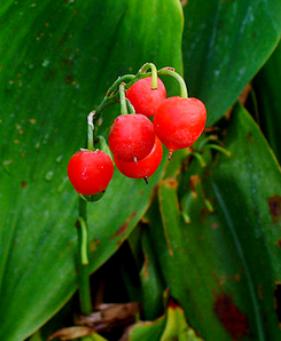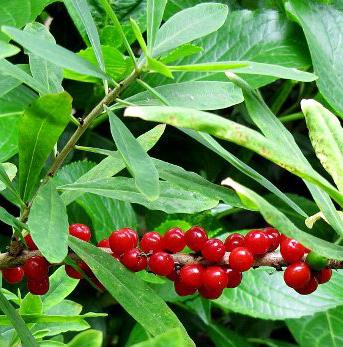What kind of berries are not in our forests! Red, blue, black, yellow, the most different. The red berry of any plant is always appetizing in appearance. Bright, beautiful, with a glossy barrel, it hangs on a twig between green leaves. The hand and reaches to tear it and put it in your mouth. But watch out! Not all red berries are safe. There are ruthless poisoners among them, by eating which you can pay with your life. Wonderful plants gave us nature. These are raspberries, strawberries, rose hips, cranberries, viburnum, lemongrass, lingonberries and many others. Their red berries are known to everyone and, perhaps, everyone knows about their benefits. They make jams and compotes, bake cakes and prepare tinctures, they are eaten raw and successfully used in medicine. But in the forest glades you can find no less beautiful red berries that you need to bypass. The people christened them “wolf”, although each of them has its own name.
Honeysuckle
This ornamental shrub is most often called wolfberry. It is found not only in forests across almost all of Russia; it is also planted as a hedge. Honeysuckle has pretty beautiful cream, white or pink flowers that bees like. Among the many varieties of this plant, there are also edible ones.
Their fruits are slightly elongated, dark blue or almost purple. In the
real honeysuckle, or forest, or ordinary, in question, the fruit is a red berry. It is small in size, spherical, very juicy, bright, shiny, perfectly adorns the bush. Often two berries grow together in pairs. Children take them for red currants. The berries of this honeysuckle taste bitter, so you won’t eat a lot of them, but it’s better not to try them. There have been no fatal cases after consuming a small amount of inedible honeysuckle. But those who tasted these berries can experience poisoning with fever, pain in the stomach, nausea, vomiting and impaired stool.
Lily of the valley
This delicate fragrant flower, pleasing us in the spring, is unusually poisonous. The fruit of the lily of the valley is a round red berry located on a stalk on thin, slightly curved stalks. Lily of the valley grows almost everywhere - in deciduous, coniferous and mixed forests, in oak forests, in gardens and flower beds. He especially likes the fringes and clearings with fairly moist soil.

Berries are kept on the plant for a long time. They pose a special danger to animals. People rarely poison them. The poison found in all parts of the flower is called konvallatoxin. Once in the body, it is able to cause cardiac arrest. In those who ate a small number of berries, all signs of food poisoning are observed. It is noteworthy that even the water in which the lilies of the valley stand is poisonous. But in strictly fixed doses, the plant is used in official medicine to treat heart disease. Traditional medicine uses lily of the valley much more widely, for example, with rheumatism, headaches, eye diseases.
Daphne is deadly
A wolf's bast, a bad guy, a wolfberry - all this is the same shrub with red berries. You can see it in the forests of Russia up to the Arctic zone. It blooms before other trees and shrubs, decorating the edges of the forest in March. Its berries are bright, juicy, very beautiful, about the size of a cherry seed.

They contain poisonous juice, when it gets on the skin and mucous membranes, itching, redness, and inflammation are observed. Symptoms of poisoning are similar to those that occur with gastroenteritis. All parts of the daphne are poisonous. They contain a large number of substances dangerous to humans - diterpenoids, coumarins, daphnin, miseerein, coccognine and others. Daphne planted as an ornamental plant in the gardens. In his recipes it was used by Avicenna. Folk healers use this plant externally, in the form of decoctions and tinctures for rheumatism, gout, tonsillitis, dermatosis, toothache and many other diseases, but it is forbidden to officially use it for medicinal purposes.
Swamp Wingfly
This very beautiful graceful plant is commonly known as calla. It is grown with pleasure on flower beds, used in bouquets. In nature, callas can be found where there is sufficient humidity. It grows in the European part of Russia, and in Siberia, and in the Far East. All its parts are poisonous. Calla flowers are small and inconspicuous, collected in yellow cobs . The white coverlet, which many take for a large petal, decorates them.

The fruit of the plant is a red berry, somewhat resembling a large mulberry on a leg. Calla juice causes irritation and inflammation of the skin, and when it enters the stomach, nausea, vomiting, cramps, and malfunctions in the heart rhythm appear. Often, leaves and fruits of calla lilies are etched by domestic animals. They begin to profuse salivation, trembling, bloating, the pulse becomes very weak, but frequent. Death without urgent action occurs within an hour. For medicinal purposes, calla rhizome is used mainly, they are added to some dishes even after special treatment.
Voronets
This grassy plant with red berries can be found in coniferous and mixed forest belts, on marsh hummocks, on clay and rocky slopes. Sometimes it is used in gardens as a decorative decoration for flower beds, mainly because of the beautiful carved leaves. The Vorontsian has many other names, including the klopovnik (due to an unpleasant odor), the stink, Christopher’s grass, and again the wolf berries. Voronet blooms in May and June. In place of small white flowers that stay on the stem for only a couple of days, berries appear.
Depending on the species, they can be not only red, but also white and black. On the stalk there are up to two dozen. They are also small, round, shiny, resembling a small bunch of grapes and very attractive in appearance. All parts of Vorontsov are poisonous. When it gets into the stomach, people get nausea with vomiting, severe pain in the abdomen, cramps, blurred consciousness.
Arum
In appearance of the flower, this plant resembles calla lilies, but its cover is not white, but dirty green-purple, similar to decaying meat. The smell is about the same. This plant needs to attract carrion and dung flies - its only pollinators. But the fruit of the Arononica is quite nice.
On a erect leg, its bright, shiny red berries look unusually attractive. The photo shows that they form something like a cob and look like beads stuck to one another. They are poisonous only while fresh. Dried berries are used in folk medicine to treat bronchitis, hemorrhoids and some other diseases. Aronnik grows almost throughout Europe and Asia. It can be seen on river banks, meadows, pastures, in bushes and on rocky slopes of mountains.
Bittersweet nightshade
There are about 1000 species in the nightshade family . Poisonous one with a variety of red berries. Black berries are quite edible, even jam from them, stewed fruit, bake pies. Solanum is found in many areas of Russia, Ukraine, Moldova, Belarus. Grows like a weed. Some gardeners plant it to decorate fences and hedges.
The fruits of nightshade are bright red, slightly elongated, resemble strongly reduced clusters of cherry tomatoes. Alkaloids, steroids, carotonoids, triterpenoids were found in their pulp and bones. The taste of the nightshade berries is sweet at first, but afterwards bitterness is felt in the oral cavity. In case of poisoning, coordination of movement is disturbed, the heartbeat becomes more frequent, abdominal pains appear.
Elderberry red
Walking in the second half of summer at the edge of the forest or in the park, you can see a sprawling shrub decorated with lush berry tassels. This is elderberry. Just do not confuse it with black edible.
This kind of elderberry does not mean at all that it has not yet matured. It’s just a completely different species of the same plant family. Red elderberry is very beautiful, so it is willingly cultivated to decorate alleys, parks and squares. Its berries are a bit like brushes of mountain ash, but the leaves and the plant itself are completely different. Birds eat its red berries with pleasure, but for humans they are poisonous because of the presence of amygdalin in them, since it turns into hydrocyanic acid in his stomach. In small doses of red elderberry, traditional medicine suggests using it as a medicine. Important: it has already been proved that red elderberry does not save cancer.
Euonymus
Probably, many will be interested in the name of the red berry of a very unusual appearance - bright, juicy, with black dotted eyes. This is a warty spindle tree. Its fruits have a rather pleasant taste, therefore they are willingly pecked by forest birds.
People, having seen this, may think that the berries are safe. But the euonymus is poisonous, and all parts of this beautiful plant are dangerous. Symptoms of poisoning with attractive berries are nausea, vomiting, diarrhea, cramps, general weakness, impaired heart function. The euonymus grows in broad-leaved groves, forests, loves oak forests and places with lime-rich soils. In settlements it can be seen as a spectacular hedge.
What to do in case of poisoning
Some authors give recommendations on how to recognize if the berries are poisonous or not. One of the main safety signs is the consumption of berries for food by birds and animals. However, focusing on this, you can pay with life. Thus, birds, without the slightest harm to themselves, eat berries of euonymus, elderberry, nightshade, honeysuckle and other poisonous plants. In order not to cause trouble, you need to be guided by another rule - if you do not know what the red berry is called and what it is, you better not touch it. According to statistics, berry poisoning is more common among children. Adults should explain to them which berries grow in their area. If poisoning did occur, before the ambulance arrives, it is necessary to rinse the stomach of the affected person, give adsorbents to drink, and ensure peace.